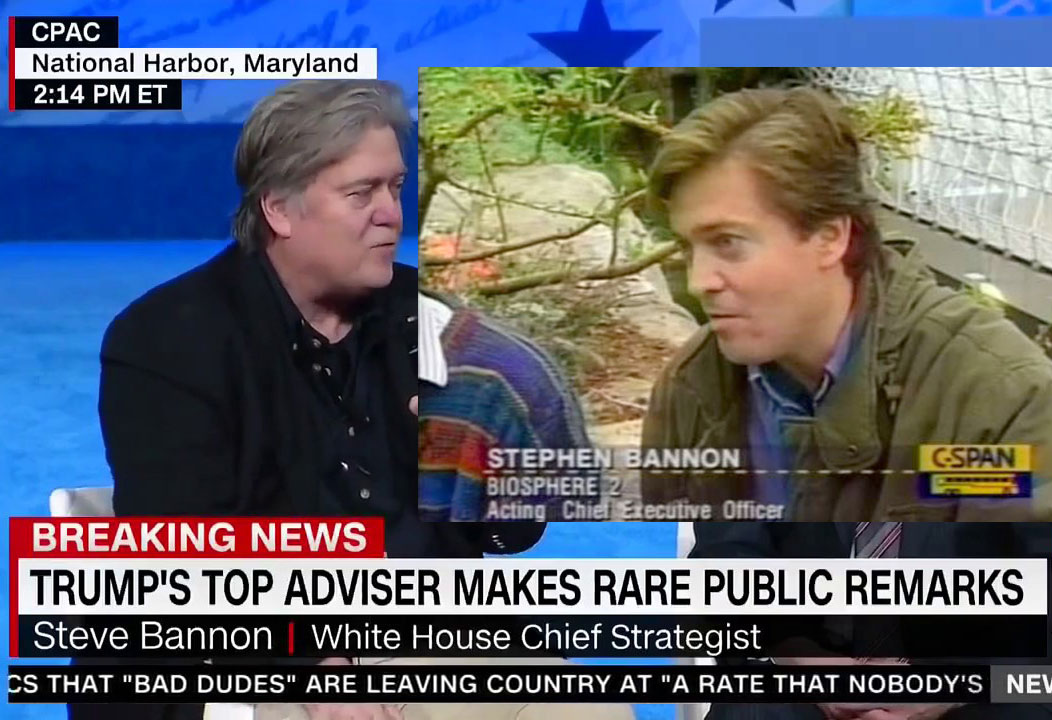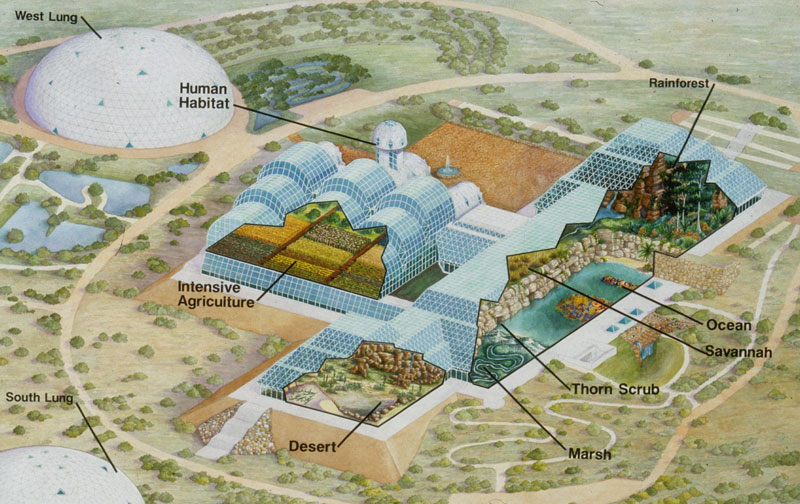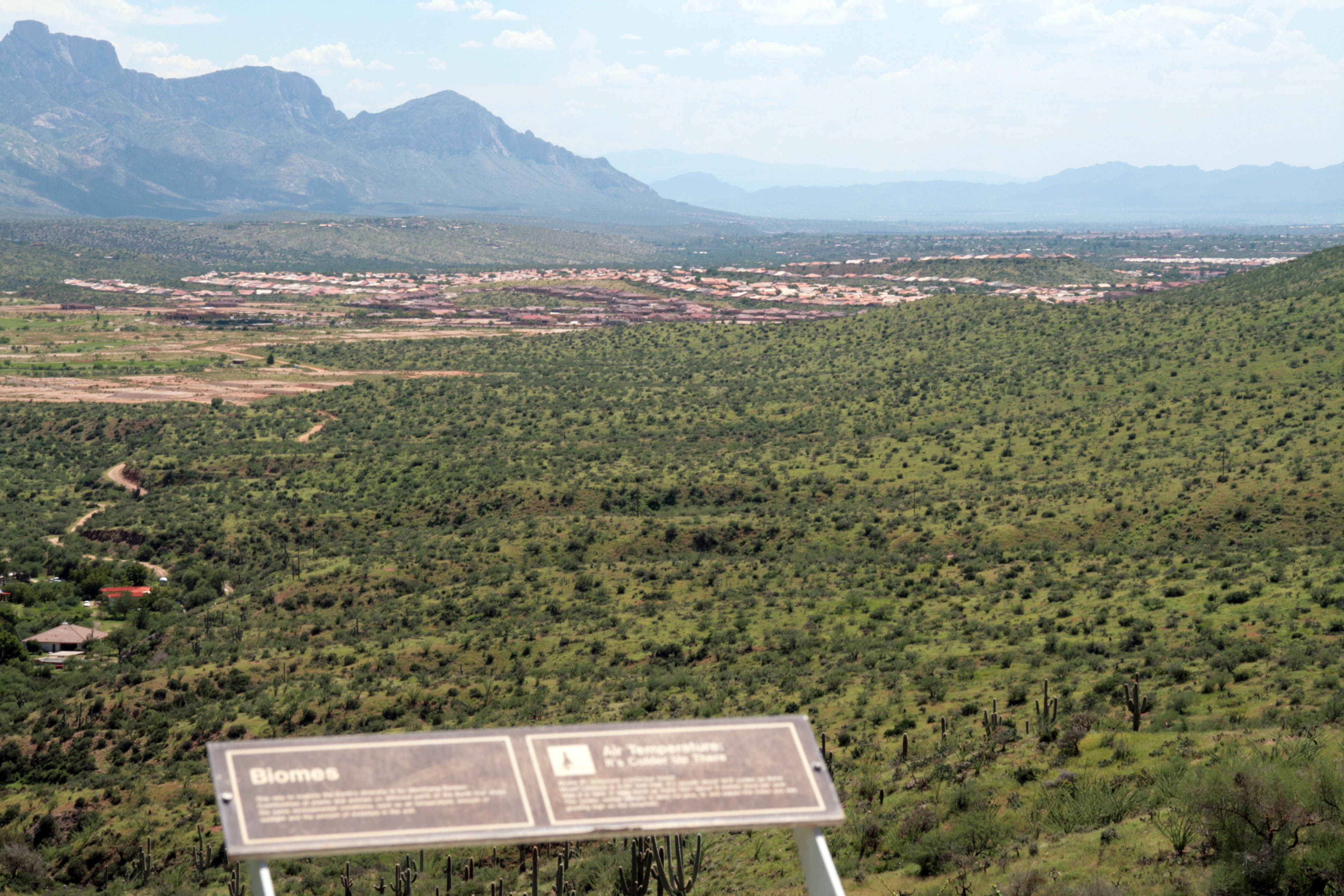Here’s an incomplete recollection of what I’ve come to know about the involvement of Steve Bannon in Biosphere 2. While fragmentary and most probably also incorrect in some details, I hope this adds some important layers on the story that I haven’t seen in other articles. It’s a subjective view of related events before the background of my meandering artistic research on the experiment’s history, which is a billion times richer and more inspiring than this telling, yet awful sideline. I highly welcome all comments, corrections, and further discussions, needless to say.

Trump’s Chief Strategist Steve Bannon Ran a Massive Climate Experiment
The Strange History of Steve Bannon and the Biosphere 2 Experiment
Steve Bannon Was Once Hired to Manage an Artificial World of People Living Under Glass (Before the Trump Campaign)
Trump’s Campaign CEO Ran a Secretive Sci-Fi Project in the Arizona Desert
Before Breitbart, before Trump, Bannon bullied people in Biosphere 2
Since past fall, I’ve got dozens of emails from friends with links to yet another article about the curious connection of the closed ecological system experiment of Biosphere 2 and Steve Bannon, former chief executive officer of Donald Trump’s presidential campaign, now the US-president’s chief strategist and attendee of the National Security Council.
Countless times I’ve replied “thanks, yes i know…” – I’ve actually known about Steve Bannon for some time. I had probably first stumbled upon him during my research on Biosphere 2, either in one of these books (1, 2, 3), or, even more probable, in my talks with Biosphere 2′s original founders: John Allen, Kathelin Gray, Mark Nelson, Marie Harding, Fred Dempster, and others. The very same people that Steve Bannon had banished from their own project on April 1st, 1994.
The link between one of today’s most central figures of the Alt-Right, often diabolically exaggerated, and a unique ecological experiment that, after 25 years, still captures the public imagination (and triggers a most wide spectrum of responses) seems right out of an overblown movie script. (And movies have indeed played an important part in this context, but that’s another story). And as often, the narrative of most news articles has been streamlined into a simple argument: Even before he turned into his current Neo-Nazi form, Steve Bannon has been batshit crazy–proven by his involvement in Biosphere 2, that crazy and failed 1990s experiment. Sounds snappy, but the actual story is a bit more complicated, and enlightening, at that. Whereas SNL’s parody of Bannon as the Grim Reaper in the White House (and the expedience of satire against Trump in general) is debatable, Bannon’s involvement in the small world under glass has effectively brought death to its small ecology.
Let’s start with some background on Biosphere 2:
The miniature world’s point of origin can be arguably traced back to a conference in Aix-en Provence in 1982. Organized by the Institute of Ecotechnics, these annual conferences brought together experts from most diverse fields of research and theory. In 1982, it was the Galactic Conference that gathered figures like Albert Hofmann, Richard Dawkins, and Buckminster Fuller. During the conference, also ideas for self-sustainable space settlements were discussed. At some point someone (was it John Allen? Buckminster Fuller?) posed a simple question, addressing to the Institute of Ecotechnics: “Who could do such a thing, if not you?” And so, they did it.
This challenge did not come totally ungrounded: Since the late 1960s, Ecotechnics members had established and run a growing list of projects reconciling ecological issues and technological approaches. They had bought and revitalized a ranch in Santa Fe, built traditional adobe houses, constructed their own ocean-going research vessel out of ferro-cement, and launched outposts in such diverse areas like the Australian outback, Kathmandu, or central London. While their Fuller-inspired synergetic lifestyle indeed integrated economy with ecology, philosophy and, perhaps most importantly, theatre practice, the rapid global expansion of their endeavors was furthermore facilitated by one member of the group with a distinct economic background: Ed Bass, heir to a Texas oil dynasty. And so, following Buckminster Fuller’s challenge, it was once more Ed Bass who formed a joint venture with the Synergia Group to start working on Biosphere 2. In 1984, Space Biospheres Ventures bought a former dude ranch and Motorola corporate retreat north of Tucson, Arizona, and construction began.
Fast forward to 1991: After several shorter experiments inside a small test module, the huge 1,27 hectare structure of Biosphere 2 was finally completed in 1991. The sealed structure housed 3800 species of plants and animals in seven biomes, including a small ocean, a desert fog, a marshland, and a rainforest. On September 26th, 1991, its final eight human inhabitants entered and joined the system, and the doors were sealed. The experiment’s goal was twofold: testing the feasibility of large-scale self-sustaining closed ecosystems for future life space, and to learn more about our own planet’s complex ecological interrelations through a scaled-down model. Although one could indeed project some post-apocalyptic ideas onto such a setup, the link between space exploration and earth’s planetary ecology has been extremely productive both for science and the popular imagination since at least the Apollo astronauts’ images of the Blue Marble; so much for the “post-apocalyptic cult” accusations against Biosphere 2, that would soon be manufactured and for some reason persist until today.

From the late 1980s, the media and a wider public had been fascinated by this unprecedented experiment. Yet, shortly before the closure, both journalists and scientists had increasingly brought up criticisms, mostly connected to the project’s background in counter-culture and non-institutional research practices. While sensationalist media reports wallowed in reactionary fantasies of communal lifestyle (this was 1991, a time when alternatives to capitalism, especially from around 1968 had been declared obsolete by the “End of History”), some scientists argued against the complex and highly transdisciplinary setup of the entire experiment (which, again to be seen within the then contemporary context, was literally based on 1930s Soviet geophysicist Vladimir Vernadsky‘s “biosphere”-concept). Over the course of the first two years mission, which indeed faced a range of unexpected problems–to be expected from such an endeavor–these criticisms mounted further, often to the point of ridiculing the entire experiment. The resulting pressure on Biosphere 2′s crew and management lead to a melange of internal conflicts and unfortunate decisions on communicating with both media and external scientists, i.e. a sort of defensive lockdown–a sort of informational closure?
In 1993, Ed Bass receives a lot of public attention as Biosphere 2′s main investor, despite being known for his reclusiveness. The board of Biosphere 2 asks for an external advisory scientific committe to be brought in. After more internal conflicts on conducting experiments and communicating results, as well as power games including and affecting the Biospherian crew, the Science Advisory Committee is asked to resign. Biosphere 2 continues to not only draw criticism, but to lose money. At least in the long run, the project was expected to become profitable , through both local tourism and technological spin-offs, like ecological engineering for both the private sector and NASA–nobody had done an experiment on that scale before. Space Biospheres Ventures hires a New York based investment banker as a consultant: Stephen K. Bannon. In the late 80s, Bannon had started at Goldman Sachs and later co-founded an investment bank specialized in media, gaining a stake in a new TV-show called Seinfeld. At the time of Bannon’s involvement with Biosphere 2, Seinfeld syndication royalties had just started to skyrocket. Members of the founding group remember Steve Bannon and Biosphere 2′s inventor John Allen discussing Sun Tzu at the compound.
“Don’t you know that billionaires always win?”
While Bannon was initially brought in to help connect with possible investors in Biosphere 2′s green technology patents, Ed Bass soon hired him as representative of Decisions Investment, through which Bass held a main stake in Space Biospheres Ventures. On behalf of Bass and supported by Bannon, lawyers were called in to do an audit on the management of Space Biosphere Ventures. According to some sources from the auditing firm, no evidence of financial mismanagement was found–but the mere fact of the audit was passed on to the media, which were eager for any “news”.
By the end of March 1994, leading managers of Biosphere 2 from the original founding group had refused cooperation with Bannon and other investment bankers. They stated both abusive behavior by Bannion and others, and that the bankers’ actual goal was to destroy the experiment. On April 1st, 1994, armed federal marshals entered the site to ban the project founders, among them creator John Allen, CEO Margaret Augustine and several members of the first mission from Biosphere 2. The restraining order, effectively a hostile takeover, was obtained by main investor Bass and chiefly orchestrated by Steve Bannon, who would become Biosphere 2′s new CEO after the take-over. One of Bannon’s quotes during the take-over: “Don’t you know that billionaires always win?”
Early April 1994 saw a turmoil of both public events and negotiations behind closed doors. Two crew members of the first mission broke the seal to the ongoing second mission, explaining their nightly activism by trying to protect the experiment, its delicate ecology, and the second crew from the irresponsible actions by the bankers in command. A few days later, John Allen, at the time in Tokyo, resigned as vice president of Space Biospheres Ventures, stating “I feel that this was an unnecessary tragedy and I offer the hand of friendship to Ed Bass to reverse the ongoing calamity and put Biosphere 2 on sound footing for the future of humanity and science.”
Within the next weeks, Ed Bass and the ousted founders negotiated organizational and financial details of their intertwined companies, which not only included Biosphere 2, but a list of other projects they had jointly started since the 1970s. Details remain under a non-disclosure agreement.
A brief overview of events since 1994
The second mission was the last experiment involving humans. It ended in September 1994, earlier than scheduled. Steve Bannon left Biosphere after two years, yet not before facing a lawsuit in which he testified to misogynist and abusive behavior against former crew members. In 1995, the experiment’s management was transferred to Columbia University, which immediately ended the deep integration of human scientists in its experiments. As Rebecca Reider describes in Dreaming the Biosphere, all traces of the original founders and their ideas had been erased from the site. Both scientists and tour guides were asked not to discuss the site’s history. While trying to promote its new “established science” approach (and thus reinforcing the former sensationalist “stunt or science?” narrative), Columbia stopped closed system research by 1996, opening the one-of-a-kind sealed structure to experimenting with various CO2 levels. The former crews’ intensive agriculture farm, yielding record harvests without artificial fertilizers, was dismantled and destroyed. In place of the animal farm, Volvo displayed a low-emission car prototype.
In 2003, Columbia stepped out after being sued for breaking their management contract and management again returned to the site’s owners. The premises were put on the real-estate market in 2005, promoting the development of ecologically-themed apartment complexes or a hotel. Since the 1980s, several gated communities, mostly aimed at retired “snowbirds”, had popped up around Biosphere 2, promising profitable development. During this period, the under-financed and -staffed facilities fell into rapid decay, both ecologically and technically. In 2007, Ed Bass’ Decisions Investments Corporation sold the site for $50 million to CDO Ranching & Development. Co-headed by Chris Bannon, Steve Bannon’s younger brother, CDO had plans for 1500 houses and a resort hotel, while keeping the greenhouse as a research facility, run by the University of Arizona. Presumably, the financial crisis of 2008 stopped these real estate developments, and the University of Arizona resumed full ownership of the main building in 2011. The overall situation, also in relation to the experiment’s history and its founders, has much improved since. After all, it’s been a quarter of a century since the takeover of Biosphere 2. Today, the structure is no longer a closed system, but an ordinary, if still impressive greenhouse. As for the surrounding site, Chris Bannon’s CDO still holds ownership today.
A vast bulk of scientific data from the first experiments has not been made available to academics or scientists, despite numerous requests over the years. Some speculate that the irreplaceable closed system data could have been lost or destroyed over the years.

The “Restructuring” of Biospheres
Before becoming Breitbart News’ CEO (following Andrew Breitbart’s death) in 2012, Steve Bannon produced documentaries on Reagan and Sarah Palin, being described as the “Leni Riefenstahl of the Teaparty movement” (A. Breitbart). His comments in an interview for the Palin documentary link his takeover of Biosphere 2 with Palin’s “success”, also sheding some light on his more recent rise and the fascist alliance of nationalism and neoliberalism:
“You’ll recall Biosphere 2 was a turnaround situation back in 1994. We didn’t know when we went in but it was in need of a restructuring,” he said in an interview. “We succeeded and I’m proud of what it has become.”
The dangerous tragedy of the “Bannon-Biosphere” complex, as promoted through countless media articles, is the interlinked double misinterpretation that
- Bannon was involved in a “climate-experiment” and thus could be interested in ecological issues; and that
- Bannon tried to “save Biosphere 2″ by “helping a group of climate scientists steer a controversial experiment in the Arizona desert back from financial chaos.”
After Trump’s election last fall, some people still wondered if Steve Bannon could perhaps remember his “ecology & climate background” and bring it to the Trump administration.
This supposed background is nothing but an accidental backdrop drawn out by shortened news stories.
Steve Bannon’s Biosphere 2 background, if anything, was a successful proof of concept of how to take-over, and ultimately destroy a world.
Thanks to Kathelin Gray for her invaluable inputs on details of Biosphere 2’s historical importance as an ecological laboratory.

One Comment
He Ralo, it’s Christine—- yeah…give them hell….can I post this on Facebook? it’s great!
Post a Comment